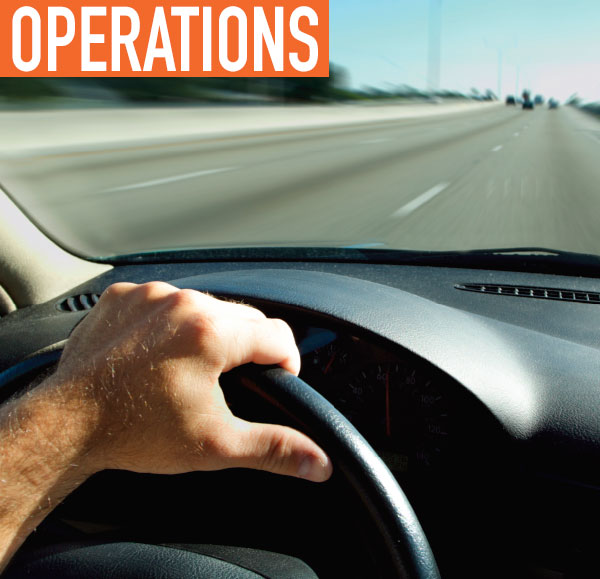From real-time audible alerts to actionable information empowered by detailed reporting, telematics offers a wide spectrum of safety performance tools for all types of fleets. The driver scorecard is a strong enforcement tool that uses telematics data.
This series looks at the costs associated with fleet safety, the impact of driver behavior, and how driver scorecards can help fleets gain control over their safety programs. This article expands on the data behind the driver scorecard and highlights the benefits.
WHAT IS THE DRIVER SCORECARD?
Telematics scorecards give fleet managers and supervisors a direct tool to work with drivers to determine if additional training is needed. A driver scorecard can be used to identify a fleet’s safest and riskiest drivers.
Specifically, the Driver Safety Scorecard Report can help to:
- Improve driver safety
- Identify risky drivers
- Recognize safe driving behavior
- Reduce the risk of accidents and traffic violations
- Enhance internal safety policies
- Lower vehicle maintenance costs
- Curb employee benefits costs
- Minimize vehicle downtime
With Geotab, the driver scorecard includes two components:
The Driver Vehicle Report that lists the different drivers or vehicles and shows their score in each measured category.
The Summary Chart that shows overall performance (whether it meets company goal or is above or below expectations).
SCORECARD FOCUS
The Driver Safety Scorecard Report focuses on three primary elements of unsafe driving: aggressive driving, seat belt usage, and speeding. All of the following behaviors can be detected by a telematics device and used to create driver scorecards. In turn, these driver scorecards can be used by fleet managers and supervisors to identify risks and continuously work toward an accident-free safety program.
1. Aggressive Driving
Aggressive driving is the cause of a large number of the 6.8 million car accidents that occur annually (according to a joint report from NETS, NHTSA, and OSHA), and this can be mitigated through the use of telematics.
Aggressive driving can emerge in different ways:
- There may be times where a driver is not focused on the road ahead and accelerates hard to catch up to traffic.
- A driver might not be focused on traffic ahead and brakes harshly to avoid a collision.
- Distracted driving can also lead to aggressive driving behavior, even if accidental.
- Stressful driving can translate to frustrated driving, and frustrated drivers are more likely to exhibit aggressive driving behavior. Stressful driving may be caused by other aggressive drivers on the road or getting stuck in traffic congestion.
Using accelerometer data, telematics can track aggressive driving. While driving, g-force is exerted on different parts of the vehicle, which means vehicles experience jolting from hard acceleration, exertion from harsh braking, and side-to-side movement from harsh cornering, all of which can be detected by a telematics device.
2. Seat Belt Usage
Wearing a seat belt is the easiest and most efficient preventive safety measure drivers can take. US employers spend an extra $5 billion annually on traffic collisions involving employees who did not wear their seat belts while driving or riding as a passenger. Having knowledge of when employees fail to wear their seat belts is extremely important and highly useful in terms of coaching opportunities.
3. Speeding Incidents
NHTSA estimates the annual economic costs of speeding-related crashes in the US to be $40.8 billion, with employers picking up an $8.4 billion chunk of this total. Speeding is arguably the most costly form of unsafe driving to US employers, and likewise the most preventable through telematics and proper coaching.
For Geotab, customers can define what constitutes speeding for their fleets. Geotab uses the posted road speeds from HERE Maps and Open Street Maps (OSM) to determine when drivers are exceeding speeds. Customers can also set up custom speed limits on routes.
A SUITE OF BENEFITS
In addition to scorecards, there are other benefits that come with using telematics.
Audible driver feedback: In the case of Geotab, another coaching tool triggers an audible response from the telematics device in the form of beeping. Driver coaching, either through buzzers or even spoken word notifications, can make drivers more conscious when they are at the wheel. Immediate alerts can be given to slow down or to buckle a seat belt.
Insurance benefits: Telematics not only improves fleet safety, it can offer a direct return on investment by lowering costs associated with unnecessary insurance claims. Insurance companies have found that the use of telematics can lead to a 45% drop in accidents, which may translate to lower insurance rates. Using a fleet telematics platform, some companies report realizing up to a 25% reduction in associated fees.
A SAFETY TOOL
Safety is an essential part of managing a fleet, and placing emphasis on safety practices can lead to a tremendously positive outcome for business health, culture, and profitability. Through telematics and the driver scorecard, fleets have direct visibility into unsafe driving behaviors—and the tools needed to analyze and measure them.
In the next article of this series, we’ll look at how driver scorecards work and the ways fleets can apply them to achieve maximum results.
FOR MORE INFORMATION
This article has been adapted from Geotab’s driver scorecard white paper by Ben Schwartz into three articles for Modern WorkTruck Solutions. Find out more about Geotab, visit www.geotab.com.
MODERN WORKTRUCK SOLUTIONS: MAY 2018 ISSUE
Did you enjoy this article?
Subscribe to the FREE Digital Edition of Modern WorkTruck Solutions magazine.
![]()







